1075
Quilted jackets, sweat pants and other brands "by Scoop"
Sweatshirt, crosses, sweat pants, cap-airfield - all original folk brands of the Soviet Union over the years. Many of these things have come to us from the outside, but soon settled down and became his, folk, and therefore deserve to remember them
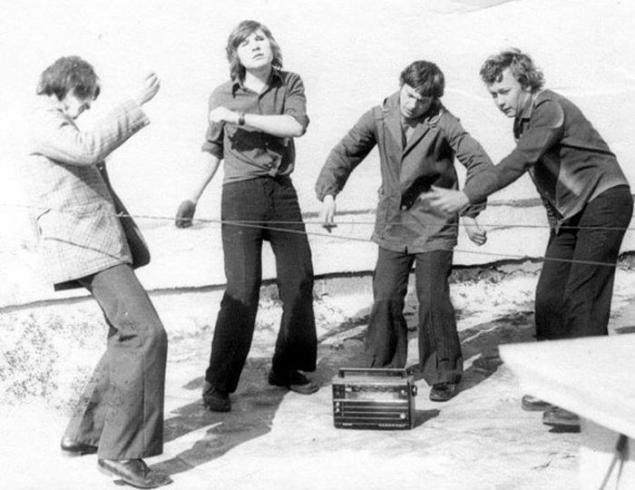
Legendary Russian overalls
Telogreyka or, as it is called, Guernsey, is the most common type of outdoor clothing in the Soviet Union. The thing is, this native Russian. In the past, it has been a fixture in the suit for people of all classes. Sported cotton stegankah and wealthy widow, and the poor peasant.
Jackets made of cotton material, and serve as insulation wool.
They wore jackets in the USSR above all the workers and soldiers. As the warm clothing they appeared in the Red Army in 1931. Quilted jacket worn under the cloak that allowed our army to endure severe frosts.
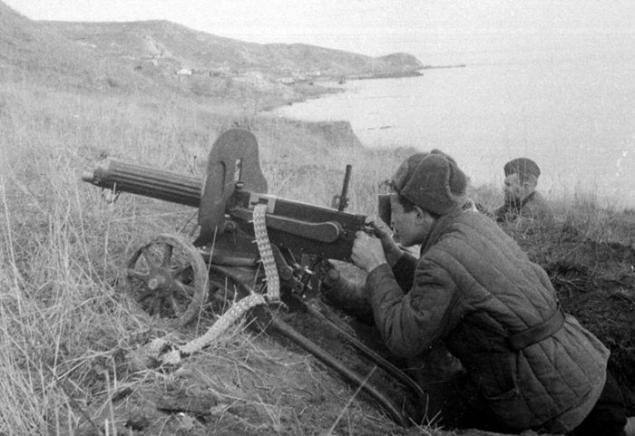
But after the Second World padded jacket has become an everyday clothing for the prisoners, who called jacket quilted jacket. In a quilted jacket had one internal and two side pockets and buttoned it five buttons. For decades jacket sewn without any changes. So for many it has become one of the symbols of the Soviet Union.

"Stalin»
Unlike the People's sweatshirt "Stalinka" (a cross between a tunic & French) were only officials. So much so that the garment has become the unofficial uniform of the party nomenklatura. In these clothes often appeared Stalin. But his example in "Stalinka" rite of officials at all levels. "Stalin" was a kind of uniform of the Soviet era.
Pants
These tunics a long pants to the early 1930's is the main men's underwear. At first they were only embroidered, wide hips and narrow at the ankles. Well, after the appearance of knitwear pants breeches acquired views.

In the Land of the Soviets pants worn by all. Khrushchev, for example, to a great age was convinced that the only kind of the lower men's underwear is pants.
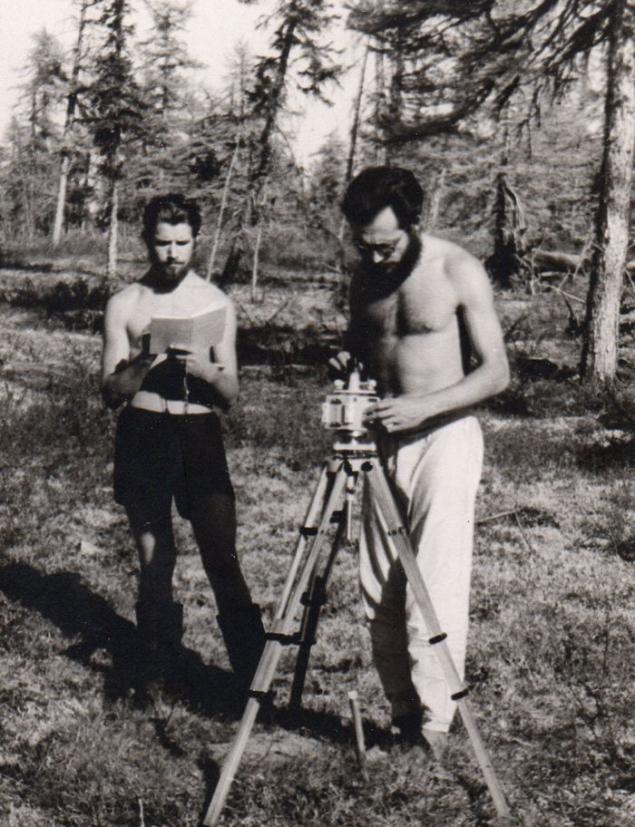
The first fight gave dudes pants. Pants-pipes are not expected to wear long underwear.
Bunch
Boxers appeared in the 1930s, they were sewn from satin and, as a rule, were knee-length.

Photo Nicholas Bakhareva.
"And where do they get only the children come from?" - Was the motto in the mid-fifties the favorite Soviet women Yves Montand in Paris opened an exhibition of Soviet underwear. During his visit to Moscow Artist filled several suitcases Soviet trousers, shirts, shirts and boxers. Brought he showed - and instantly became a "banned entry" in our bulwark of socialism.
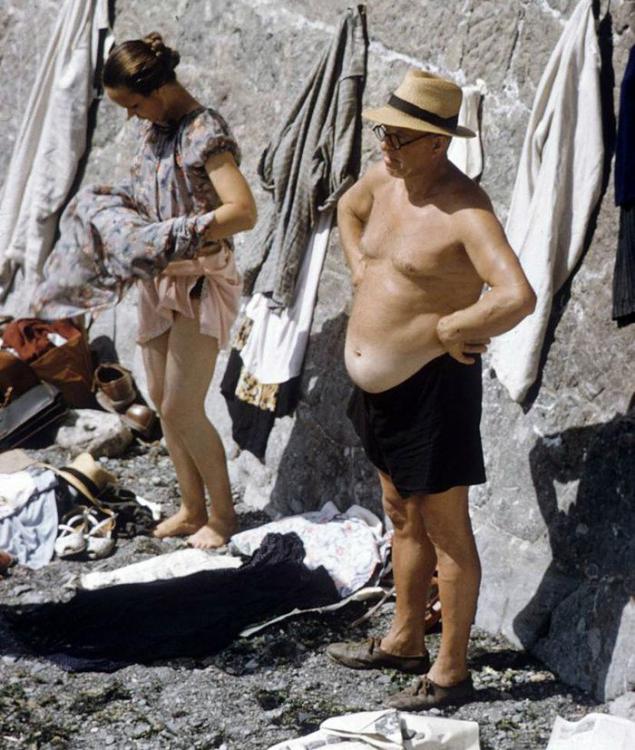
Only since the mid-60s, Soviet mods instead of long underpants were worn trunks.
Pajamas
With pajamas Russian citizen met in the XIX century. In the early twentieth century it was the view of home clothes representatives of the bourgeoisie. However, with the formation of the Soviet elite, and the individual apartments for the range of pajamas have become re-enter the everyday consumption.
In 1956 the magazine "worker" unfolded on the pages of a stormy debate on the pajamas. The man in the striped pajamas associated with the Stalinist past. It is no accident in the film "Three plus two" (1963), where positive, modern-minded heroes rest "savages" as unworthy of alternatives put forward a "cultural holidays" in a sanatorium, signs of which are the "three meals a day and pajama stripes».
Tights
In the postwar years seamed stockings were riding the dream of any girl, but with the advent of mini-skirts have become a vital necessity tights. For the first time they were in the Soviet Union from Czechoslovakia, the names for these stockings sewn together in the Russian language was not so stuck Czech kalhoty. The price tags on the store for a long time kept a different name - "Chulkovo breeches».
Did tights made of cotton, wool, nylon and nylon. This cotton tights slid askew or blisters on his knees, wool Full leg and nylon and nylon exploded. Hooked accidentally - and ran the shooter. But our girls are not lost. They learned how to darn stockings own hair. Or hair girlfriend suitable color. However, most often plastered disrupt the loop colorless nail polish to run no further. And those who are not getting tights, not philosophizing, sewn to the panty stockings.

Flared
Flared gained massive popularity in the 60s of the last century. Flared jeans that hippie embroidered flowers symbolized freedom.
In the 70 years of fashion bottoms reached and the Soviet Union.

In the absence of Soviet youth jeans "flared" ordinary trousers, including uniform pants school students. "Flared" leg from the knee, the width of a flare was regulated, if the width of the pants under the maple tree was 21 cm, at the bottom, at the ankle, - 23.
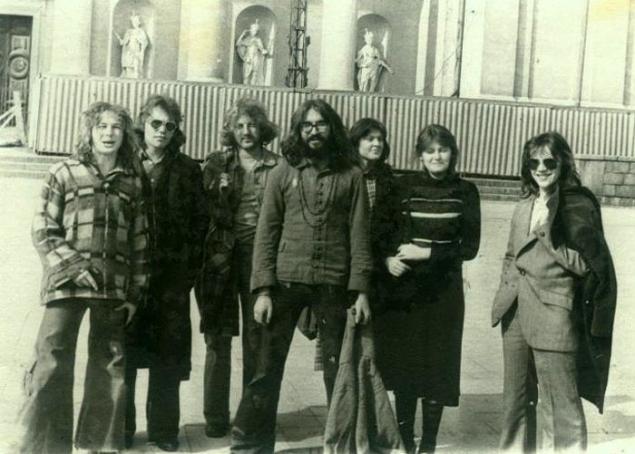
Later, there were more fashionable models - "format" 23 to 25, and some extreme athletes wore bell-bottoms 27 to 32 centimeters, but in the studio are not sewed pants, arguing it is only one word: not allowed!
And teachers and other "educators" massively hunted for dissidents by measuring the circumference of the leg edge ruler and centimeters.

Alas, flared jeans have not been able to keep their positions in the fashion competition with other models.
"Begalki" and "runners»
Until the 80s the Soviet people did not even know of the existence of such thing as running shoes. Surprisingly, the cult of sports in the Soviet Union peacefully coexisted with a deficit of sportswear. Inexperienced Soviet athlete knew only "sweats" with extended knees, a hair's breadth as a dunce in the "Adventures of Shurik", and sneakers, which is popularly called "begalkami" or "Skorohodov».
Spravdelivo for were still flannelette and wool suits, but in the warmer months, they were hot!
Athletes dragged domestic blue and red sneakers with rubber balls at the ankles and massive as clown shoes, noses. Rare lucky could get yourself the Chinese white crosses, the color of which was revived with the help of ... toothpaste.
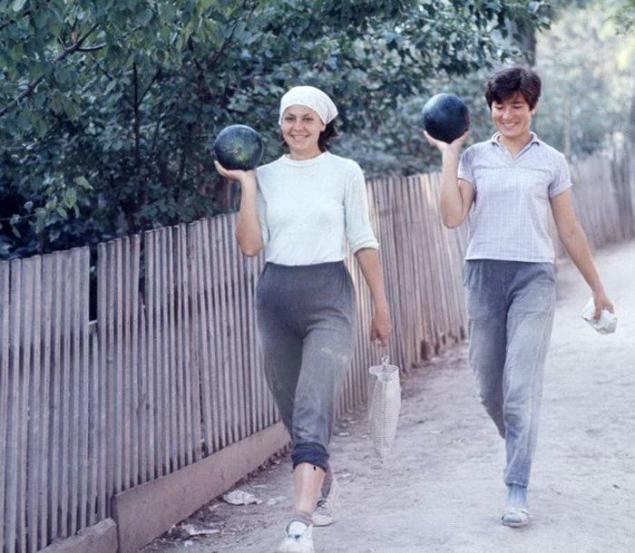
Cap-airfield
In the 1970s, these hats bore almost the entire population of the Soviet south. With the collapse of the Soviet Union became the Caucasian cap out of fashion. Now furazhechnyh workshops in the Caucasus is almost gone. After all, a simple-looking style requires precision work. Inside the cap - a complex structure.

Headgear literally for 10 minutes until tender looks like a shapeless cap. The secret to a perfectly flat surface that is not afraid of no rain, no wind - specially treated burlap.

"Adik»
Few people know that the shoes "Adidas" Soviet Union "gave" the legendary Olympic Games-80. As you know, the Politburo in 1972, solving the issue of equipping the Soviet Olympic team, has chosen on this label. So shoes with triple band not only in vogue but also have become truly iconic thing in the Soviet Union.

After the Olympics-80, which Soviet athletes dressed and shod capitalist "Adidas", the Union of the scope of this adidasomaniya. Trainers have acquired the status of the front, even exquisite shoes, they were put on ... even in the theaters and restaurants.
"Adik" had the status thing. They were never in the rain shoes, they did not play football and did not take to school physical education. Is that a disco - show off.
The first Soviet "Adidas" started to produce the Moscow Experimental Plant of sports products "Sport" in 1979. The first and only model "Adidas", produced in the Soviet Union in those years, it was dark-blue sneakers with three white stripes and yellowish rubber sole. Despite the fact that in the West, this model quickly outdated in the USSR it had no "shelf life" and became a reference for many generations.

P.S.
In place of the narrow trousers came flared hipsters changed hippie, change the mini to the max ... And then everything went down in history - "and pointy shoes, and long-tailed blonde" ... But it was not too much time - and the vanguard of the '70s has become a classic. He even named the buzzword "vintage". Retro is back in fashion!
As noted by one famous artist Sofia Azarkh, "in the 70s and the weather was better and happier people, and all wore bell-bottoms ...»


Legendary Russian overalls
Telogreyka or, as it is called, Guernsey, is the most common type of outdoor clothing in the Soviet Union. The thing is, this native Russian. In the past, it has been a fixture in the suit for people of all classes. Sported cotton stegankah and wealthy widow, and the poor peasant.
Jackets made of cotton material, and serve as insulation wool.
They wore jackets in the USSR above all the workers and soldiers. As the warm clothing they appeared in the Red Army in 1931. Quilted jacket worn under the cloak that allowed our army to endure severe frosts.

But after the Second World padded jacket has become an everyday clothing for the prisoners, who called jacket quilted jacket. In a quilted jacket had one internal and two side pockets and buttoned it five buttons. For decades jacket sewn without any changes. So for many it has become one of the symbols of the Soviet Union.

"Stalin»
Unlike the People's sweatshirt "Stalinka" (a cross between a tunic & French) were only officials. So much so that the garment has become the unofficial uniform of the party nomenklatura. In these clothes often appeared Stalin. But his example in "Stalinka" rite of officials at all levels. "Stalin" was a kind of uniform of the Soviet era.
Pants
These tunics a long pants to the early 1930's is the main men's underwear. At first they were only embroidered, wide hips and narrow at the ankles. Well, after the appearance of knitwear pants breeches acquired views.

In the Land of the Soviets pants worn by all. Khrushchev, for example, to a great age was convinced that the only kind of the lower men's underwear is pants.

The first fight gave dudes pants. Pants-pipes are not expected to wear long underwear.
Bunch
Boxers appeared in the 1930s, they were sewn from satin and, as a rule, were knee-length.

Photo Nicholas Bakhareva.
"And where do they get only the children come from?" - Was the motto in the mid-fifties the favorite Soviet women Yves Montand in Paris opened an exhibition of Soviet underwear. During his visit to Moscow Artist filled several suitcases Soviet trousers, shirts, shirts and boxers. Brought he showed - and instantly became a "banned entry" in our bulwark of socialism.

Only since the mid-60s, Soviet mods instead of long underpants were worn trunks.
Pajamas
With pajamas Russian citizen met in the XIX century. In the early twentieth century it was the view of home clothes representatives of the bourgeoisie. However, with the formation of the Soviet elite, and the individual apartments for the range of pajamas have become re-enter the everyday consumption.
In 1956 the magazine "worker" unfolded on the pages of a stormy debate on the pajamas. The man in the striped pajamas associated with the Stalinist past. It is no accident in the film "Three plus two" (1963), where positive, modern-minded heroes rest "savages" as unworthy of alternatives put forward a "cultural holidays" in a sanatorium, signs of which are the "three meals a day and pajama stripes».
Tights
In the postwar years seamed stockings were riding the dream of any girl, but with the advent of mini-skirts have become a vital necessity tights. For the first time they were in the Soviet Union from Czechoslovakia, the names for these stockings sewn together in the Russian language was not so stuck Czech kalhoty. The price tags on the store for a long time kept a different name - "Chulkovo breeches».
Did tights made of cotton, wool, nylon and nylon. This cotton tights slid askew or blisters on his knees, wool Full leg and nylon and nylon exploded. Hooked accidentally - and ran the shooter. But our girls are not lost. They learned how to darn stockings own hair. Or hair girlfriend suitable color. However, most often plastered disrupt the loop colorless nail polish to run no further. And those who are not getting tights, not philosophizing, sewn to the panty stockings.

Flared
Flared gained massive popularity in the 60s of the last century. Flared jeans that hippie embroidered flowers symbolized freedom.
In the 70 years of fashion bottoms reached and the Soviet Union.

In the absence of Soviet youth jeans "flared" ordinary trousers, including uniform pants school students. "Flared" leg from the knee, the width of a flare was regulated, if the width of the pants under the maple tree was 21 cm, at the bottom, at the ankle, - 23.

Later, there were more fashionable models - "format" 23 to 25, and some extreme athletes wore bell-bottoms 27 to 32 centimeters, but in the studio are not sewed pants, arguing it is only one word: not allowed!
And teachers and other "educators" massively hunted for dissidents by measuring the circumference of the leg edge ruler and centimeters.

Alas, flared jeans have not been able to keep their positions in the fashion competition with other models.
"Begalki" and "runners»
Until the 80s the Soviet people did not even know of the existence of such thing as running shoes. Surprisingly, the cult of sports in the Soviet Union peacefully coexisted with a deficit of sportswear. Inexperienced Soviet athlete knew only "sweats" with extended knees, a hair's breadth as a dunce in the "Adventures of Shurik", and sneakers, which is popularly called "begalkami" or "Skorohodov».
Spravdelivo for were still flannelette and wool suits, but in the warmer months, they were hot!
Athletes dragged domestic blue and red sneakers with rubber balls at the ankles and massive as clown shoes, noses. Rare lucky could get yourself the Chinese white crosses, the color of which was revived with the help of ... toothpaste.

Cap-airfield
In the 1970s, these hats bore almost the entire population of the Soviet south. With the collapse of the Soviet Union became the Caucasian cap out of fashion. Now furazhechnyh workshops in the Caucasus is almost gone. After all, a simple-looking style requires precision work. Inside the cap - a complex structure.

Headgear literally for 10 minutes until tender looks like a shapeless cap. The secret to a perfectly flat surface that is not afraid of no rain, no wind - specially treated burlap.

"Adik»
Few people know that the shoes "Adidas" Soviet Union "gave" the legendary Olympic Games-80. As you know, the Politburo in 1972, solving the issue of equipping the Soviet Olympic team, has chosen on this label. So shoes with triple band not only in vogue but also have become truly iconic thing in the Soviet Union.

After the Olympics-80, which Soviet athletes dressed and shod capitalist "Adidas", the Union of the scope of this adidasomaniya. Trainers have acquired the status of the front, even exquisite shoes, they were put on ... even in the theaters and restaurants.
"Adik" had the status thing. They were never in the rain shoes, they did not play football and did not take to school physical education. Is that a disco - show off.
The first Soviet "Adidas" started to produce the Moscow Experimental Plant of sports products "Sport" in 1979. The first and only model "Adidas", produced in the Soviet Union in those years, it was dark-blue sneakers with three white stripes and yellowish rubber sole. Despite the fact that in the West, this model quickly outdated in the USSR it had no "shelf life" and became a reference for many generations.

P.S.
In place of the narrow trousers came flared hipsters changed hippie, change the mini to the max ... And then everything went down in history - "and pointy shoes, and long-tailed blonde" ... But it was not too much time - and the vanguard of the '70s has become a classic. He even named the buzzword "vintage". Retro is back in fashion!
As noted by one famous artist Sofia Azarkh, "in the 70s and the weather was better and happier people, and all wore bell-bottoms ...»






















